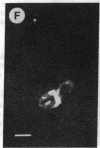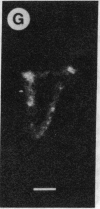Abstract
We have identified cells in the central nervous system of the marine mollusc Aplysia that react with antibody raised against the small cardioactive peptide B (SCPB). Antisera to this neuropeptide stained a subset of central neurons that include the large identified buccal neurons, B1 and B2. The distribution of SCP-containing neurons was used in a strategy to isolate a cDNA clone encoding the precursor protein for the peptide. RNA from neurons B1 and B2 and from cells that did not stain with SCPB antisera was used to direct the synthesis of radiolabeled cDNA probes. A cDNA clone complimentary to mRNA specifically expressed in the B1 and B2 cells was isolated by differentially screening a buccal cDNA library with these probes. The cloned cDNA segment is 1394 nucleotides in length and contains a 408-base-pair open reading frame. The predicted precursor protein is composed of 136 amino acids and has a characteristic hydrophobic leader sequence. The sizes of the precursor protein with and without this leader sequence agree with in vivo and in vitro labeling studies. The amino acid sequences for SCPB and a related peptide, SCPA, are present and are flanked by known proteolytic processing sites.
Full text
PDF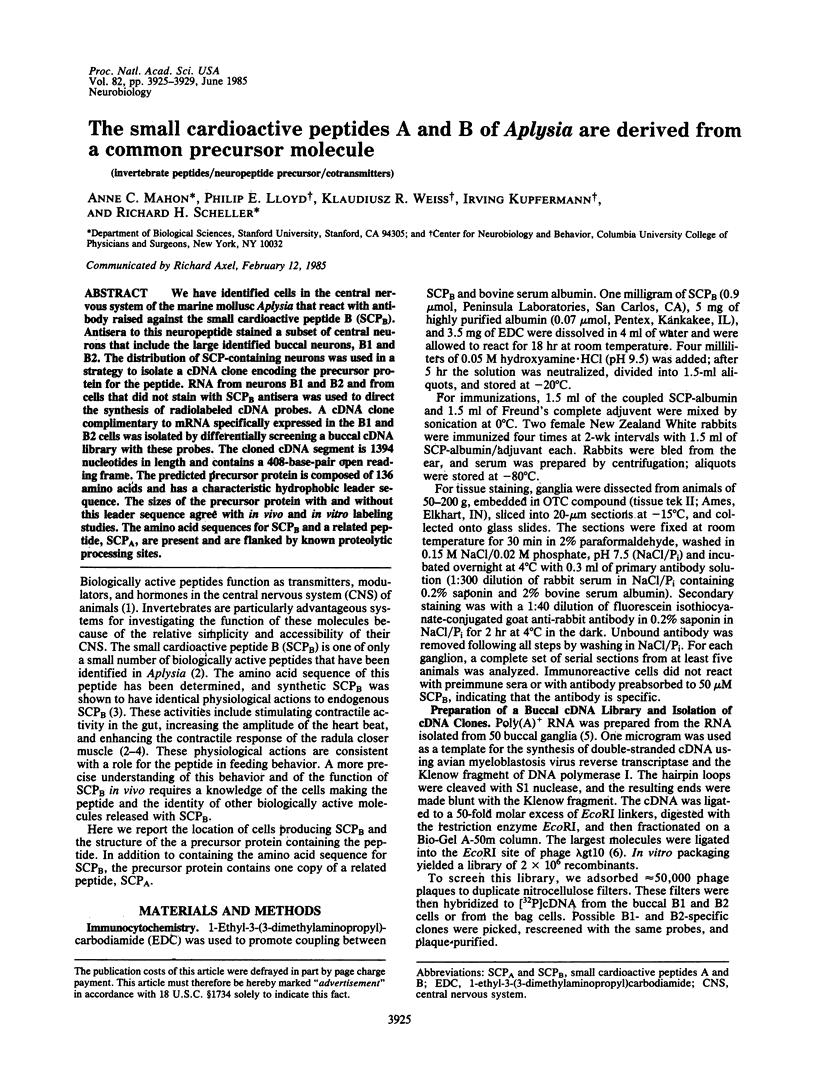
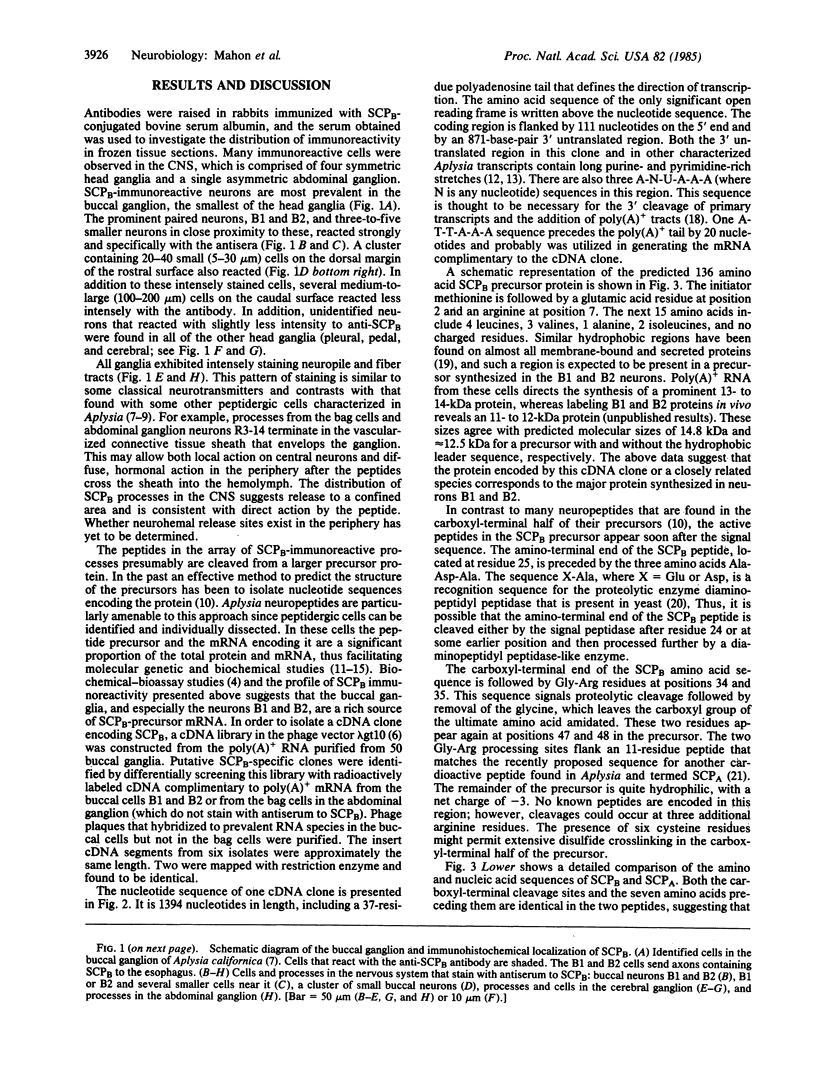
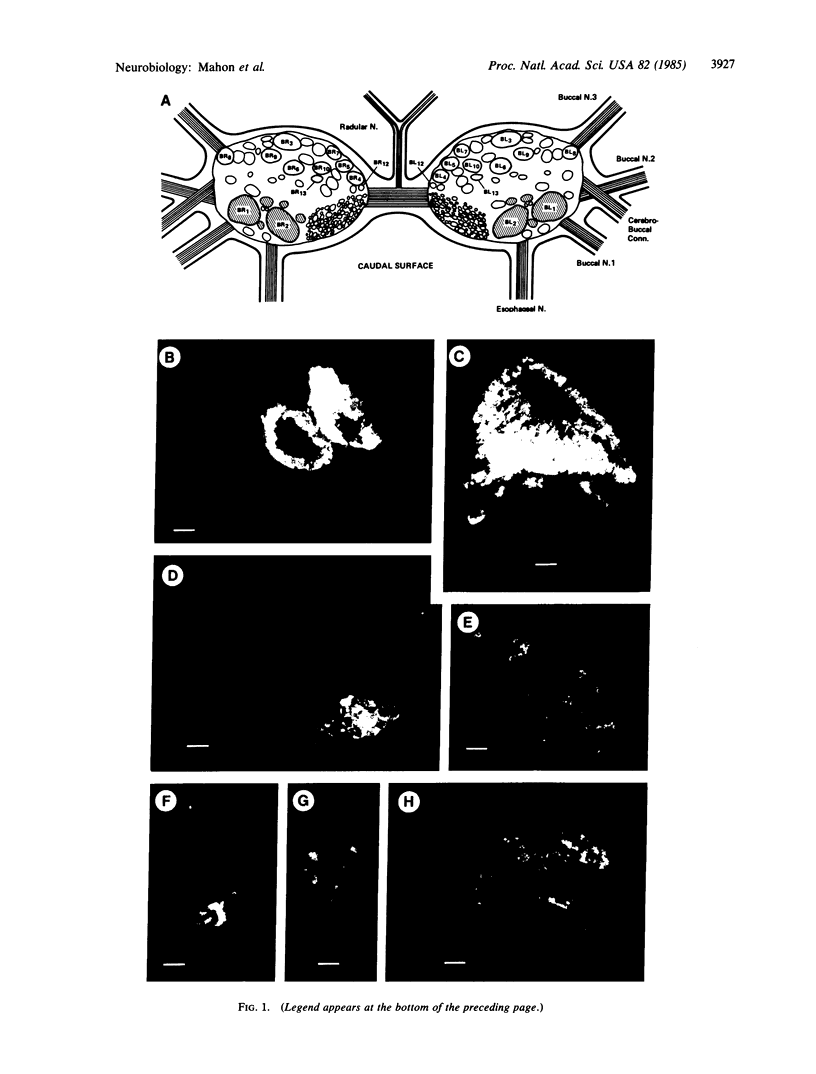
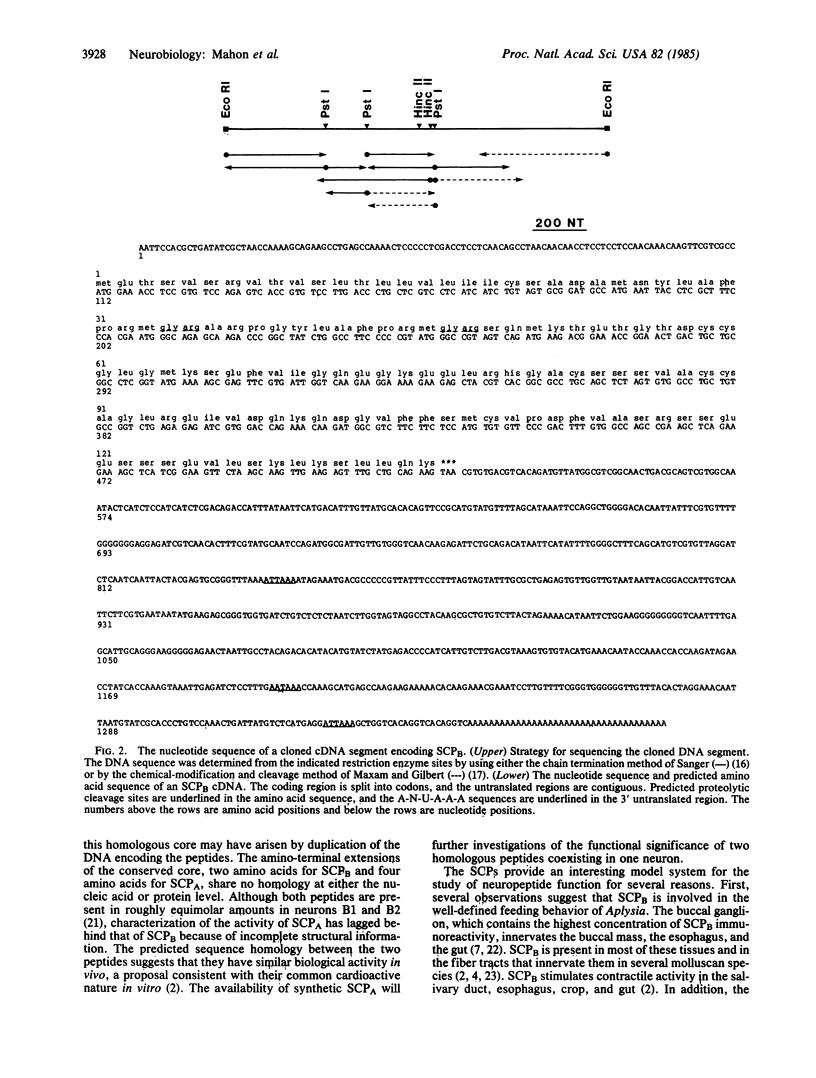
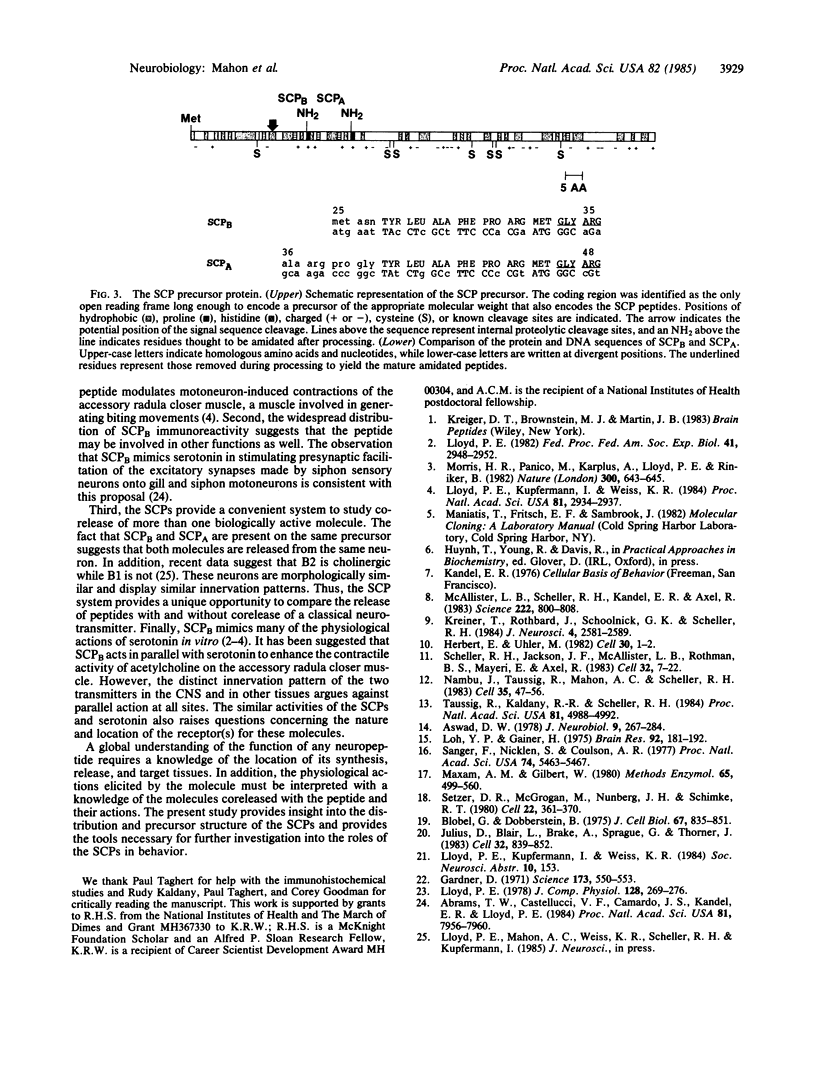
Images in this article
Selected References
These references are in PubMed. This may not be the complete list of references from this article.
- Abrams T. W., Castellucci V. F., Camardo J. S., Kandel E. R., Lloyd P. E. Two endogenous neuropeptides modulate the gill and siphon withdrawal reflex in Aplysia by presynaptic facilitation involving cAMP-dependent closure of a serotonin-sensitive potassium channel. Proc Natl Acad Sci U S A. 1984 Dec;81(24):7956–7960. doi: 10.1073/pnas.81.24.7956. [DOI] [PMC free article] [PubMed] [Google Scholar]
- Aswad D. W. Biosynthesis and processing of presumed neurosecretory proteins in single identified neurons of Aplysia californica. J Neurobiol. 1978 Jul;9(4):267–284. doi: 10.1002/neu.480090404. [DOI] [PubMed] [Google Scholar]
- Blobel G., Dobberstein B. Transfer of proteins across membranes. I. Presence of proteolytically processed and unprocessed nascent immunoglobulin light chains on membrane-bound ribosomes of murine myeloma. J Cell Biol. 1975 Dec;67(3):835–851. doi: 10.1083/jcb.67.3.835. [DOI] [PMC free article] [PubMed] [Google Scholar]
- Gardner D. Bilateral symmetry and interneuronal organization in the buccal ganglia of Aplysia. Science. 1971 Aug 6;173(3996):550–553. doi: 10.1126/science.173.3996.550. [DOI] [PubMed] [Google Scholar]
- Herbert E., Uhler M. Biosynthesis of polyprotein precursors to regulatory peptides. Cell. 1982 Aug;30(1):1–2. doi: 10.1016/0092-8674(82)90002-2. [DOI] [PubMed] [Google Scholar]
- Julius D., Blair L., Brake A., Sprague G., Thorner J. Yeast alpha factor is processed from a larger precursor polypeptide: the essential role of a membrane-bound dipeptidyl aminopeptidase. Cell. 1983 Mar;32(3):839–852. doi: 10.1016/0092-8674(83)90070-3. [DOI] [PubMed] [Google Scholar]
- Kreiner T., Rothbard J. B., Schoolnik G. K., Scheller R. H. Antibodies to synthetic peptides defined by cDNA cloning reveal a network of peptidergic neurons in Aplysia. J Neurosci. 1984 Oct;4(10):2581–2589. doi: 10.1523/JNEUROSCI.04-10-02581.1984. [DOI] [PMC free article] [PubMed] [Google Scholar]
- Lloyd P. E. Cardioactive neuropeptides in gastropods. Fed Proc. 1982 Nov;41(13):2948–2952. [PubMed] [Google Scholar]
- Lloyd P. E., Kupfermann I., Weiss K. R. Evidence for parallel actions of a molluscan neuropeptide and serotonin in mediating arousal in Aplysia. Proc Natl Acad Sci U S A. 1984 May;81(9):2934–2937. doi: 10.1073/pnas.81.9.2934. [DOI] [PMC free article] [PubMed] [Google Scholar]
- Loh Y. P., Gainer H. Low molecular weight specific proteins in identified molluscan neurons. I. Synthesis and storage. Brain Res. 1975 Jul 11;92(2):181–192. doi: 10.1016/0006-8993(75)90268-1. [DOI] [PubMed] [Google Scholar]
- Maxam A. M., Gilbert W. Sequencing end-labeled DNA with base-specific chemical cleavages. Methods Enzymol. 1980;65(1):499–560. doi: 10.1016/s0076-6879(80)65059-9. [DOI] [PubMed] [Google Scholar]
- McAllister L. B., Scheller R. H., Kandel E. R., Axel R. In situ hybridization to study the origin and fate of identified neurons. Science. 1983 Nov 18;222(4625):800–808. doi: 10.1126/science.6356362. [DOI] [PubMed] [Google Scholar]
- Morris H. R., Panico M., Karplus A., Lloyd P. E., Riniker B. Elucidation by FAB-MS of the structure of a new cardioactive peptide from Aplysia. Nature. 1982 Dec 16;300(5893):643–645. doi: 10.1038/300643a0. [DOI] [PubMed] [Google Scholar]
- Nambu J. R., Taussig R., Mahon A. C., Scheller R. H. Gene isolation with cDNA probes from identified Aplysia neurons: neuropeptide modulators of cardiovascular physiology. Cell. 1983 Nov;35(1):47–56. doi: 10.1016/0092-8674(83)90206-4. [DOI] [PubMed] [Google Scholar]
- Sanger F., Nicklen S., Coulson A. R. DNA sequencing with chain-terminating inhibitors. Proc Natl Acad Sci U S A. 1977 Dec;74(12):5463–5467. doi: 10.1073/pnas.74.12.5463. [DOI] [PMC free article] [PubMed] [Google Scholar]
- Scheller R. H., Jackson J. F., McAllister L. B., Rothman B. S., Mayeri E., Axel R. A single gene encodes multiple neuropeptides mediating a stereotyped behavior. Cell. 1983 Jan;32(1):7–22. doi: 10.1016/0092-8674(83)90492-0. [DOI] [PubMed] [Google Scholar]
- Setzer D. R., McGrogan M., Nunberg J. H., Schimke R. T. Size heterogeneity in the 3' end of dihydrofolate reductase messenger RNAs in mouse cells. Cell. 1980 Nov;22(2 Pt 2):361–370. doi: 10.1016/0092-8674(80)90346-3. [DOI] [PubMed] [Google Scholar]
- Taussig R., Kaldany R. R., Scheller R. H. A cDNA clone encoding neuropeptides isolated from Aplysia neuron L11. Proc Natl Acad Sci U S A. 1984 Aug;81(15):4988–4992. doi: 10.1073/pnas.81.15.4988. [DOI] [PMC free article] [PubMed] [Google Scholar]




